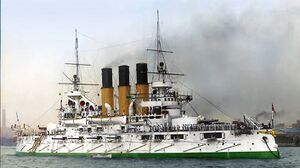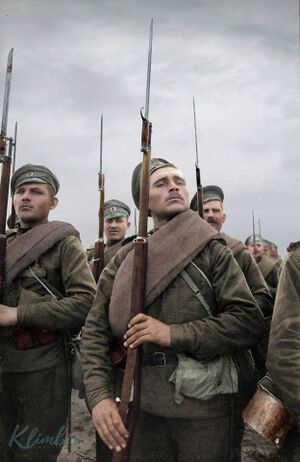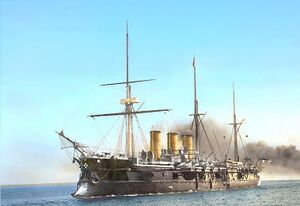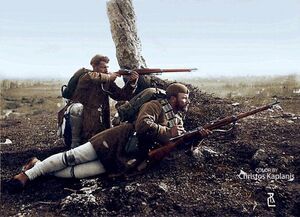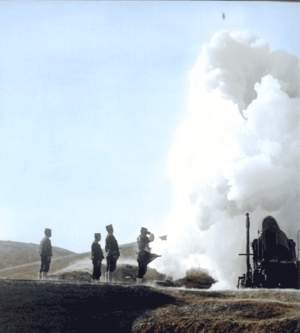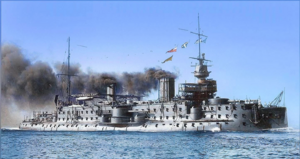Third Chryse War
| Third Chryse War | |||||||
|---|---|---|---|---|---|---|---|
 Syaran cavalry and infantry marching in Chryse. | |||||||
| |||||||
| Belligerents | |||||||
|
|
| ||||||
| Commanders and leaders | |||||||
|
|
| ||||||
| Units involved | |||||||
|
Górska Federal Defense Forces Ruvelkan Red Army | Armed Forces of the Syaran Republic | ||||||
| Strength | |||||||
|
|
| ||||||
| Casualties and losses | |||||||
|
|
| ||||||
The Third Chryse War was fought from June 1905 to April 1909 between the Republic of Syara and an alliance of Górska and the Ruvelkan Socialist Republic.
The origin of the conflict lay in unresolved border disputes that had originated with the dissolution of the Rioni Union, which led to a multitude of territorial conflicts between the Syaran Successor States and Górska over the island of Chryse, and against the Ruvelkan Imperium and later the Ruvelkan Socialist Republic over the regions of Zemplen and Imerti. After the Kingdom of Galania had failed to recapture Zemplen in the Galanian-Ruvelkan War, the Kingdom of Symmeria decisevly defeated the Ruvelkans in the Ruvelkan-Symmerian War. The threat posed by the socialist republic was a major catalyst for the Unification of Syara, resulting in the formation of the Republic in 1875. The newly united Syara completely altered the balance of power in the Western Sundering Sea. Górskan leadership was especially alarmed at this development, as it rendered Górskan claims to Chryse severly mitigated by the Federal Republic being dwarfed by Syara. Facing a common threat, Górska and Ruvelka began forging ties in 1890s in response to Syaran military buildup and modernization.
Residual tensions between Syara and the Górska-Ruvelkan Pact boiled over into armed conflict, beginning with a surprise attack on the Syaran port of Sena by the Górskan Federal Navy on 21 June, 1905 to pre-emptively cripple the Navy of the Syaran Republic. Górskan troops then invaded Chryse while Ruvelkan armies invaded Zemplen, Imerti, Symmeria, and Hayreniky. Hopes for a quick victory were dashed as the Syarans reinforced Chryse and managed to halt the Ruvelkan advance at the West Lushan River, but the Syarans were unable to prevent the Ruvelkans from making serious inroads into Zemplen. Extensive usage of trenches, and mass employment of heavy artillery and machine guns turned the fighting on land into a stalemate, but Górskan plans to destroy the Syaran fleet while at anchor failed. In the winter of 1905-1906 the Syarans launched a series of counter-offensives which drove the Ruvelkans back to the pre-war border, but a second counter-invasion into the Kunhegyes District in the spring failed. In the summer the Syarans drove the Ruvelkans from Hayreniky and shelled Aszod by sea, but a Ruvelkan offensive into Zemplen in Autumn 1906 seized Sopron.
The Syarans attempted to break the deadlock in spring 1907 with an invasion of the Balatonalmádi District, but it was repulsed in heavy losses. Frustrated by failures in Siduri, the Syarans shifted focus towards Chryse and managed to repel Górskan efforts to capture Svajec and Konta. Renewed efforts against heavy Górskan resistance managed to regain control of half the island by winter 1907; Górskan demands for assistance led the Ruvelkan Red Army to invade Galania in March 1908, which ended in unsuccessful sieges of Kedziebrzych, Krasnovan, and Mislava. Between summer and autumn however the Syaran navy inflicted a series of defeats on the Górskan Federal Navy, culminating in an attack on Kalikie that crippled the Górskan fleet. Unable to challenge the Syarans at sea, Górska unilaterally negotiated an armistice and withdrew from the war. Syara was unable to leverage its gains to achieve success against Ruvelka; over the winter of 1908-1909 the Ruvelkans solidified their control over Zemplen and a Syaran attempt to dislodge them in spring 1909 ended in costly failure. An armistice was negotiated but an official peace treaty was never signed; this was rendered irrelevant by the collapse of the Socialist Republic in 1914.
Syaran historian Temenuga Kostenceva classified the Third Chryse War as "a conflict in which everyone seemingly lost". Górska managed to expand their control of Chryse to include roughly half the island, but this fell short of their original goal of total control, while the annihilation of its fleet effectively brought an end to Górskan challenges to Syara for influence over the island. Ruvelka gained territory and recovered most of Zemplen and Imerti, but the war bankrupted and destabilized the already tumultuous Socialist Republic and contributed heavily to the December Uprising in 1914. Syara was forced to cede territory on both fronts, but was eventually able to regain Zemplen and Imerti during the Ruvelkan Civil War. The war disrupted international trade that flowed through the Sundering Sea, while significant damage was done to Syaran, Ruvelkan, and Górskan port cities.
The Third Chryse War foreshadowed the mechanized, attritional struggle that would define warfare in the 20th Century. Widespread proliferation of machine guns led to murderous casualties in landwarfare, while the heavy usages of trenches and artillery resutled in protracted deadlocks for ground forces. The war also marked a turning point in naval warfare; it was the last major clash of pre-dreadnought battleships, while also seeing the combat debut of dreadnoughts through the Syara-class dreadnoughts. The conflict saw the first usage of aerial bombardment when Syaran airships dropped munitions on Ruvelkan troops, while armored cars made their first apperance on the battlefield. Armored trains and railway batteries were also utilized, along with many other technologies that would later be employed in greater numbers in the Divide War.
Background
The end of the Second Chryse War in 1859 resulted in the Kingdom of Makedon exercising control of 70% the island of Chryse, leaving Górska with the remaining northern portion of the island. Per the terms of the treaty, the Górskans and Makedonians were supposed to revisit the issue of the island's domain after period of 25 years during which a non-aggression pact would remain in place. This period of peace was largely kept to by both sides despite occasional flare ups of tension. Makedonian focus on the island began to dissipate amid rising tensions with the Ruvelkan Socialist Republic in the mid-1860s. The outbreak of the Ruvelkan-Makedonian War had originally offered Górska the opportunity to retake the island while the Makedonian military was distracted, but Ostrołęka opted to adhere to the terms of the peace treaty, a decision that seemed validated when the Makedonians rapidly inflicted a decisive defeat on the Ruvelkan Red Army and reclaimed the territories of Zemplen and Imerti.

Among the ramifications of the war was the galvanization of Syaran nationalism and an increased push among the Syaran Successor States for the Unification of Syara. This was eventually accomplished in 1875 with the Conference of Parilla, which officially established the Republic of Syara. With it, ownership of Makedonian Chryse passed from the Makedonian Kingdom to the Syaran Republic. News of Syaran unification was unwelcome in Górska, especially among those who desired Górskan control of Chryse. Whereas Górska had been able to maintain rough parity with the Makedonians, unified Syara considerably outstripped Górska in numerous categories. The combined population of Syara was 76 million compared to Górska's 18 million, Syaran steel production was 11 times higher, and in 1895 alone Syara laid more kilometers of railroad than Górska had done since 1885. It became a common fear among Górskan political and military circles that Syara would employ its superior position to seize Chryse in its entirety.
Such fears did not materialize, but following the lapse of the non-aggression pact in 1884 negotiations intended to firmly settle the question of Chryse began. Zovahr, recognizing it was in the position of power between the two, insisted on compromises that favored Syara. Both sides had expressed a desire for a unified rail network that connected all the major urban settlements, but Syara insisted that the railway tracks be on gauge of 1,520mm, the same as the rest of Syara but different from Górska's 1,435mm. This would mean most of the rolling stock and locomotives would have to come from Syara, meaning Syaran rail firms and businesses would benefit from the project and subsequent traffic. While the Syarans agreed that the Górskan navy would be free to port at the island and the Górskan army would maintain a garrison, Syara insisted that port control authority would rest with the Syaran armed forces, and inspections be carried out by Syaran officers.
The Górskan government recognized that agreeing to Syaran terms would effectively place transportation both within Chryse and between Chryse and the rest of Tyran under Syaran control and refused to agree to them. Although negotiations were restarted in 1889, 1894, and 1901, no major agreements could be reached. Continued concern within the Górskan government that Syara would simply abandon negotiations and employ her larger armed forces to seize Chryse led to a substantial military buildup among the Górskan Federal Defense Forces. Despite the rising tensions the Syaran government did not consider a military confrontation likely due to the disparity in power between the two states, with Zovahr remaining convinced that Ostrołęka would eventually concede as Syara's economic and political influence continued to grow.
Prelude and preparations
In 1903 Kacper Wilkosz was elected to the Federal Council, Górska's Executive body. Wilkosz, a native of Chryse who's father had perished during the Second Chryse War, was heavily focused on resolving the Chryse Question which he saw as the key to Górska's geopolitical future. With the support of fellow Councilors Leokadiusz Kołodziejczyk, Narcyz Graczyk, and Ryszard Kułak, Wilkosz opened negotiations once more with Zovahr and Syaran President Penko Todorov Deliivanov. Deliivanov, fresh off and election and still dealing with the aftermath of a socialist-inspired uprising among Galanian peasants, was largely unfocused on the Chryse issue and reiterated Syaran demands. Wilkosz attempted to agree to Syaran demands for rail construction in exchange for leaving Górska's ports on Chryse in Górskan hands, but Deliivanov refused the compromise. Wilkosz continued to press the issue repeatedly with Deliivanon, and during a meeting in Zovahr in September 1904 Deliivanon allegedly grew so frustrated with the Councilors repetitions that he threatened "take the whole damn island and toss your lot off the closest beach". While said in a moment of frustration, the remark left Wilkosz speechless and he departed the negotiations to return to Górska.
Subsequent efforts were made in October and November but likewise failed to achieve an agreement. Meanwhile tensions between Syara and the Ruvelkan Socialist Republic flared up over Syaran accusations of Ruvelkan subterfuge, leading to the mobilization of the Armed Forces of the Syaran Republic. While they were stood down in a few weeks, the event alarmed Ostrołęka and Wilkosz in particular, believing the event showed that Syara could and would resort to military might to achieve its strategic goals. Further announcements in December 1904 that the Navy of the Syaran Republic would pursue the creation of additional Republic-class battleships convinced Wilkosz that the Syarans would eventually reach the point of insurmountable military advantage over Górska and would simply sieze Chryse at their leisure. Faced with that Wilkosz saw as a "do or die" situation, he pressed the Federal Council to seek war.
While Councilors Ryszard Włodarczyk and Waldemar Słowiński initially opposed the idea, Wilkosz was able to leverage support from Kołodziejczyk, Graczyk, and Kułak to bring the Federal Council around to the idea. Wilkosz painted the war as a necessary measure given Syara's rapid growth as an industrial power; if Górska did not strike now, Syara would eventually simply overpower them and take Chryse without any real challenge. Fearing the fate of the Górskan inhabitants of Chryse and the loss of its historic territory and commerce, the Federal Council agreed to order military action to seize Chryse.
Following the decision, General of the Armed Force Tadeusz Madej was summoned and ordered to begin preparations for a conflict with Syara. While initially reluctant to the idea of war, Madej eventually acquiesced and began drawing up plans of attack. Madej eventually settled on a two stroke move; first, an attack against the Syaran fleet anchored at Sena, with a concurrent drive on Chryse to seize control of the island. The strike at Sena was seen as necessary to balance out the superior numbers of the Syaran navy, giving Górska free reign in the Sundering Sea and around Chryse.
The Górskan Federal Defense Forces in January 1905 amounted to 300,000 men in uniform, around 210,000 in the army and 90,000 in the navy. The army was divided into six divisions, three cavalry brigades, and four independent artillery regiments. An additional three infantry brigades could be called up as needed, with additional reserves capable of manning three more divisions. The navy was composed of 43 warships, including 4 battleships, 8cruisers, 7 ironclads, 14 frigates, and 10 corvettes. While the Górskan military was smaller than the Syaran armed forces, it was considered well armed and well trained, having been drilled and instructed by foreign advisors following the Second Chryse War.
The Armed Forces of the Syaran Republic consisted of the Army of the Syaran Republic and the Navy of the Syaran Republic. The Army was composed of 650,000 men organized into four corps of three divisions each, with an additional five cavalry brigades. An additional eight divisions of reserves were available while Syaran artillery was plentiful; the Syarans possessed over 4,000 field guns and had already invested heavily in machine guns and mortars. However, most of the Army had to be stationed along Syara's extensive border with Ruvelka owing to the two nations' hostile relations with one another. The Syaran navy consisted of 78 warships, including 10 battleships, 23 cruisers, 25 torpedo-boats, 15 frigates, and 10 corvettes. While the Syarans were not counted among Tyran's leading naval power, they enjoyed a substantial numerical advantage over Górska, making a pre-emptive strike on the Syaran fleet to cripple its long term abilities essential to a Górskan victory.
Beginning in January 1905 and continuing until March the Górskan army began secretly moving troops into Górskan Chryse, raising the garrison from 15,000 troops to over 60,000. By March Górska had amassed 65,000 troops on the island in addition to more than 1,000 field guns, over 70% of all field guns in the Górskan arsenal. Syaran forces on Chryse remained at 25,000 troops supported by 300 guns, and missed early warnings about the Górskan buildup.
Course of the war
On 13 March 1905 at 2030 local time the Górskan fleet departed from Kalikie and sailed south towards Sena. Sena had been identified by Górskan intelligence as the location of the Syaran Northern Fleet; the Górskan fleet was to sail and bombard the Syaran fleet, crippling the Syaran navy's ability to challenge Górskan intentions for Chryse. The fleet, commanded by Admiral Walerian Ciesielski, consisted of 18 ships and was spearheaded by the battleship Zuzanna. In order to conceal the movement from its true intentions, the Górskan Admiralty had publicly declared sea drills were to be conducted the prior week. Sailing at night at high speeds, Admiral Ciesielski endeavored to avoid contact with any other ships, but crossing through the most trafficked sea lane in the world made that impossible. Nevertheless the commonality of Górskan sea drills meant that even though this information was reported through the Syaran naval intelligence channels, the Syarans were unaware of the details of the situation until it was too late.
The Górskan fleet arrived outside Sena around 0530 local time on 14 March, having sailed through the night at top speed. According to Ciesielksi's report, the cruiser Roksana opened fire first. She was soon joined by the rest of the fleet, which shelled the Syaran fleet at anchor for over an hour before increasing return fire from the Syaran fleet and coastal batteries forced the Górskans to retreat. Despite frantic attempts to mount a pursuit, the Górskans were able to successfully evade the Syarans and withdraw back to Kalikie by nightfall. The fleet had escaped with only minor damage and was back in Górskan waters.
However, the attack had ultimately failed. The Górskan fleet had arrived to discover that the bulk of the Syaran fleet was not at anchor in Sena; a week prior much of the Northern Fleet had sailed west to temporarily port in [[Moddra] for exercises with the Western Fleet. The 16 ships the Syarans had in Sena included the Nemaro-class battleship RS Spirit of Unity, which had received moderate damage in the attack. Ultimately however the Górskan attack had sunk only three vessels; the light cruiser Faithful Servant, the frigate Interloper and the corvette Arbiter. The decisive opening strike of the war had failed to land a killing blow on the Syaran navy, and instead had left the bulk of Syaran fleet intact.
The next on 15 March the Górskan forces on Chryse unleashed their offensive against the Syaran garrison. The operation, called Plan Dionizy, involved 50,000 Górskan troops organized into four divisions facing off against 25,000 Syaran troops. Despite the attack of the previous day, Syaran units on Chryse were just learning of the development, and orders to assume defensive positions were still being passed down Syara's still developing radio network on the island when Dionizy was launched. Within the course of a few days the Syarans had been driven back across the island; on 18 March the Górskans captured Slawya and the next day seized Moredia. Major General Veselin Steriovski, commanding Syaran troops on Chryse, gave the order to withdraw and reform a defensive line along the Pozzów-Tarastiv-Kolov axis on 20 March.
The Górskans struck the Syaran defenses on 24 March and by 2 April had ruptured the line, sending the Syarans streaming south. Losing much of their heavy equipment including mortars and machine guns, Steriovski ordered the Syaran forces to really around Svajec, hoping that the Górskans would drive east towards Bilozerske instead and allow the remaining Syarans to strike at their exposed left flank. Instead the Górskans, led by General Alfons Worzałła, struck east towards Svajec and surrounded the city after a week of fighting. Despite several breakout attempts the Syarans were unable to defeat the encirclement, and were forced to surrender on 8 April after running out of ammunition. The Górskans seized the city and prepared to move south towards the port of Volozova, but by now Syaran reinforcements from the mainland were beginning to make landfall. By 18 April the Syarans had dispatched some 30,000 troops to Chryse and began setting up a new perimeter around the Briken river, intent on blocking any Górskan advance towards either Volozova or Bilozerske.
Having pushed their own supply lines to the limit, the Górskans elected to set up their own defensive positions along the Achrionian Hills south of Svajec, allowing them to control the main rail lines between the Syaran cities in southern Chryse. Syaran forces, now under the command of Lt. General Evgeni Lyobenov Hristov and 40,000 strong, assaulted Górskan positions throughout mid-to-late April but was unable to break through. After several costly infantry attacks, Hristov requested additional reinforcements and supplies of heavy artillery to break the Górskan defenses.
At sea, the Syaran Navy had regrouped between 15-20 March and split into two groups, East Cluster under Admiral Zoran Vitez and West Cluster under Senior Captain Efrem Dimosvki. Vitez, leading 19 ships centered on the Republic-class battleship RS Clarity of Grace, wanted to sail north and force the Górskan Navy to give battle, while Dimovski preferred launching raids against the Górskan forces in Chryse and their naval support and sea lanes. The Górskan fleet, still under the command of Admiral Ciesielski, now saw the primary purpose of the Górskan navy as safeguarding the supply lines that ran from Górska to Chryse, a relatively short distance but just enough to be threatened by Syaran naval forces.
On 28 March the Eastern Cluster and Ciesielski's fleet clashed 45 kilometers east of Chryse in an inconclusive skirmish that saw both sides lose a single frigate. The Górskans withdrew back north towards the protection of their coastal batteries and the rest of their fleet, while the Syarans withdraw back south, unwilling to press without a decisive advantage in numbers. Vitez, having failed to decisively engage the Górskans, began planning for a pincer movement between the two Syaran Clusters, which would converge on the Hajrenye Channel between Chryse and Górska with the intent of trapping and destroying the Górskan navy. Dimovski protested, citing the difficulty of both coordinating the two fleets on opposite sides of Chryse, while also pointing out the difficulty of guaranteeing the presence of the Górskan fleet. Vitez continued to push for the plan, but on 2 April the Western Cluster engaged the Górskan navy 26 kilometers west of Chryse and suffered the loss of the cruiser Resolute Favor and the frigate Persistence. Alarmed by the loss of two ships for none inflicted on the Górskan fleet, Vitzen agreed to abandon the idea for the time being and reigned in naval operations to focus on southern Chryse.
The month of April was spent by both navies skirmishing and scouting with little major action, while the stalemate on Chryse itself extended into May. On 12 May Field Marshal Lucio Kochanova arrived on Chryse in the south along with 45,000 more Syaran troops, bringing the total number close to 100,000 in addition to more than a 1,000 field guns. While this had been ongoing Górska had reinforced its own forces with an additional 30,000 troops, bringing their total number to around 70,000. The Górskans were strung along a defensive line that ran from the Acrhionian Hills south of Svajec west past the Briken River until it reached the Golden Forest, approximately 45 kilometers north-east of Bilozerske.
Backed by heavy artillery the Syarans unleashed their offensive (Operation Radoslav) on 22 May. Despite a withering artillery bombardment across the Górskan lines and repeated Syaran assaults, the Górskan forces managed to hold their position for more than a week before General Worzałła gave permission for the Górskans to withdraw. Electing to abandon Svajec, Worzałła re-established his lines closer to the center, ceding the Hetarian Peninsula north-east of Svajec and anchoring his defensive line running from Machaen's Bay east towards Golden Forest. The Syarans pursued the Górskans back north into the interior of Chryse but found the Górskans dug in amid long lines of trenches defended by artillery and machine guns, making infantry attacks costly endeavors.
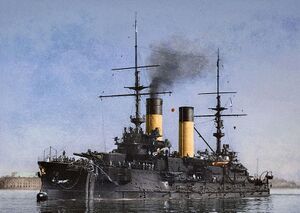
Spring showers soaked Chryse throughout late May and June, turning the ground to mud, made only worse by the movement of men, cannons, and horses across the land. Syaran and Górskan soldiers alike described the land as a "sea of mud" which made large scale movement of forces difficult. Offensive actions were almost impossible due to so many men becoming bogged down in mud, and as a result Kochanova was forced to suspend all major attacks against the Górskan lines, utilizing the momentary cessation to call upon further reinforcements and supplies of heavy weapons and ammunition. While the fighting on the land subsided, the battles at sea began to intensify.
Grand Admiral Ljudevit Mikulčić, overall commander of the Syaran Navy, had recognized the numerical superiority Syara possessed and overruled Vitez's strategy of dividing Syara's naval forces. On 23 May Mikulčić ordered Vitez to withdraw the Eastern Cluster south to safeguard Syaran supply lines over the Veylo Channel while the Western Cluster was reinforced with ships from the Western Fleet, raising its total number to 35 vessels. Rather than launch raids and shelling on Chryse, Mikulčić ordered Dimovski to sail north and raid along the coastline of Górska itself. Dimovski obliged and on 27 May the Syaran fleet appeared near the port of Rzeszcie and shelled the docks, destroying several trawlers, tug boats, and a cargo ship. On 3 June the fleet sailed north and engaged a Górskan flotilla of patrol craft and corvettes, sinking the Róża. For the next three months Dimovski's fleet would repeatedly shell and harass the Górskan coastline while declining battle with the Górskan navy, which was unable to mount the numbers necessary to trap the Syaran fleet or prevent it from escaping.
On land, the heat of July finally baked the mud of central Chryse dry and allowed the Syarans to resume the offensive. By now the Syaran forces on Chryse numbered 125,000 with 1,300 guns against 100,000 Górskan troops holding a defensive line 90 kilometers long. Despite the advantage of numbers, the strong Górskan defenses, coupled with plentiful artillery and machine guns arrayed across their trenches, made Mikulčić attempt to avoid direct engagements and instead opted to try and isolate exposed salients and sectors of the line. While this effort was successful in reducing Syaran casualties, General Worzałła proved adept at countering Syaran maneuvers and was able to either reinforce the threatened sectors quickly or withdraw his forces before the Syarans could unhinge the Górskan defenses.
As July turned into August the Syarans found themselves with little to show for their efforts. Despite thousands of casualties and numerous assaults on the Górskan defenses they had gained just 40 kilometers. Unable to achieve a breakthrough with his forces available, Kochanova requested additional reinforcements. With tensions between Ruvelka and Syara still fairly high in spite of the ongoing war, mustering up the additional forces for Chryse proved more difficult than expected, and it wasn't until late August that the Syarans were able to increase their numbers to above 150,000 troops. Backed up by 1,800 artillery pieces, the Syarans outnumbered and outgunned the Górskan army of 120,000 men and 1,000 guns, but elaborate Górskan defenses rendered any Syaran offensive difficult and arduous. On 11 August the Syarans struck with 100,000 men on a 40 kilometer front against the Górskan lines after a 10 hour bombardment. Despite the immense shelling the Górskans fought tenaciously to hold onto their positions, finally ceding back the towns of Lipna and Kistalis on 15 and 17 August respectively. The attack had cost the Syarans 2,000 men killed and an additional 8,000 wounded, but hopes that it would develop into a larger victory failed to appear as the Górskans withdraw again to secondary defensive positions, along what became known as the Tihomir Line.
By September, the Górskan Navy had been left reeling after months of skirmishes and inconclusive fighting with the Syaran fleet. The war's lack of definitive moments was wearing Górskan public opinion thin, and the seeming inability of the Górskan Navy to stop them had resulted in a panicked flight of Górskan citizens from many ports and towns near the coast, driven by fear of Syaran shelling and raids. Senior Admiral Gabriel Płonka, commander of the Górskan Navy, found himself in the impossible position of trying to fight against a numerically superior enemy while also needing to maintain his fleet close to home waters to protect Górskan supply lines to their forces on Chryse.
In Syara, Grand Admiral Mikulčić's awareness of the stalemate on land led to the proposal of a feint maneuver followed by a decisive strike against the Górskan Navy. Mikulčić proposed massing much of the Syaran fleet near the eastern coast of Chryse, coupled with leaked reports of troop building and transportation intended to give the impression that the Syarans planned to launch an amphibious invasion of Chryse from behind the front lines, cutting off the Górskan forces from their supply lines and encircling the Górskan army on Chryse. When the Górskan Navy sallied forth to fight, the Syaran fleet would withdraw, and after the Górskans returned to port the Syarans would strike against them and catch them at anchor, reversing how the Górskans had begun the war.
The Syaran fleet began massing its available ships off the eastern coast of Chryse beginning on 9 September, while telegrams and radio reports in Syara began hinting at the large scale boarding of troop transports by Syaran soldiers in Makedonian ports. Górskan intelligence quickly picked up on the developments and began warning that the Syarans likely intended an amphibious landing either in Chryse or Górska itself. Admiral Płonka immediately assembled the Górskan fleet and on 16 September took up positions along the coast to contest the effort, leading to several days of stalemate as the Górskan fleet waited for the Syarans to make their move. After two weeks of inaction however the Syaran fleet remained on location, and on 30 September reports from Górskan intelligence indicated that the Syaran troop transports had not left port and radio reports of such movements had ceased. Believing the maneuver had been a ruse designed to draw the Górskan fleet into battle, Płonka ordered his forces back to port.
This had all in fact been planned by the Syarans, and on October 5th after it was confirmed that the Górskan fleet was back in port Senior Captiain Dimovski's fleet set sail in the evening, leaving its concealed positions along the Scitarian-Makedonian coastline and headed north. Rather than hug the coastline of Chryse to save time, the Syarans sailed away from Chryse before swinging abruptly east towards the Hajrenye Channel. While still under cover of nightfall the Syarans slipped past the Górskan patrols where the Sundering Sea meets the Sanguine and entered the Hajrenye Channel. As dawn broke over Kalikie, the headquarters of the Górskan Federal Navy, the Górskan fleet at anchor came under fire from the Syaran task force. In the ensuing three hours the Syaran fleet laid waste to the port facilities, repair sites, docks, and infrastructure of Kalikie before breaking contact and withdrawing, sailing south for Syaran waters.
The attack proved crippling for the Górskan navy. Out of 34 ships at anchor, the Górskan Navy had lost two battleships, three cruisers, four frigates, and three corvettes. Having started the war with 43 warships, the Górskan Navy had lost 21 vessels in exchange for 13 Syaran ships. With their fleet now crippled, Syaran victory at sea seemed all but inevitable. On 8 October the Federal Council met to discuss the possibility of ending the war. Wilkosz was adamant that Górska avoid any talk of "surrender", but ultimately agreed that the Republic should consider requesting a ceasefire. However, he was also not eager to see Górska give up its hard fought gains on Chryse itself, and informed Madej that the Górskan army would need to fight to hold its position at all costs in order to give Górska some room to maneuver at the negotiating table.
The destruction of Kalikie did not result in any major breakthrough on land. Despite amassing over 150,000 troops, two major Syaran offensives in October failed to yield a decisive breakthrough. On 28 October the Syarans launched their final operation of the war aimed at capturing the small city of Orrki 5 kilometers behind Górskan lines. After a four hour bombardment the Syaran infantry arose form their foxholes and trenches to attack, but heavy machine gun fire and counter bombardments resulted in little progress. Field Marshal Kochanova called off the attack three days ahead of schedule and put forth another request for reinforcements, asking for the total troop numbers on Chryse to exceed 200,000 Syarans.
It never came. On 2 October Councilor Wilkosz requested a ceasefire from President Deliivanov. The initial reaction from the Syaran President was negative, who believed that the Górskans were attempting to weasel out of their seemingly inevitable defeat with their navy now gone. Before Deliivanov could refuse the offer however, his cabinet urged that the notion be discussed in full, which Deliivanov acquiesced to. After several hours of deliberations, during which the heavy casualties being suffered, coupled with still uneasy tensions within Galania and socialist insurrections sponsored by the Ruvelkan Socialist Republic, Deliivanov eventually agreed to accept the ceasefire rather than have the conflict drag on long enough for another crisis to erupt and strain the Republic further.
Aftermath and legacy
The ceasefire was instituted on 2 October and delegates from both governments met in Chryse the next day. Councilor Wilkosz proposed that the border between the two states be recognized in accordance with the current state of the front line, while Deliivanov demanded the return of pre-war borders. After several days of negotiations it was agreed that the borders would be determined by the front line; in exchange the Górskan government would accept responsibility for starting the conflict, agree to accept Syaran intentions for Chryse's internal transportation network, and a lump sum payment of war reparations totally in modern numbers $5 billion. Deliivanov's willingness to accept the status of the borders surprised some observers, and is often attributed to his bearing witness to the aftermath of the carnage that resulted from the last Syaran offensive while taking a ride to the negotiations.
The Treaty of Chryse went into effect on 12 November and officially ended the war. Despite frequent expectations among foreign observers that Syara and Górska would engage in hostilities again over Chryse, the outbreak of the Syaran-Ruvelkan War just two years later would mark the end of Syaran-Górskan hostilities as the major political conflict of north-west Siduri. The trench warfare dominated by artillery and machine guns would foreshadow the bloodshed of the coming war with Ruvelka, as well as the Divide War.
The outcome of the war, and it's victor, has long been disputed. Górska failed in its efforts to achieve total control of Chryse, but managed to gain significant territory and forced Syara to accept partitioning of Chyrse. However the Górskan Federal Navy was decimated in the fighting, and any chance of challenging Syara at sea was effectively eliminated. While Syara's Navy had performed well, it's Army had noticeably struggled on Chryse despite advantages in numbers and firepower. Syara had also ceded almost 20% of Chryse in a war that Górska had started, despite seemingly ending the war in a position of strength. Nevertheless, Syara had maintained control over the majority of Chryse, and had effectively neutered any immediate future threat from Górska. The Treaty of Chryse would be reaffirmed by the Commonality of Syara in 1989 after the Refusal War, and remains in place to this day.
Syaran historian Temenuga Kostenceva, writing in 1999, concluded that the Third Chryse War "set the stage for the industrial scale killing that would define warfare of the 20th century". In her assessment of the capabilities and performances of both sides, Kostenceva deduced that the Syaran army's poor performance on Chryse would foreshadow its efforts against the Ruvelkan Red Army just two years later. The Syaran Navy on the other hand, had performed well, with Kostenceva arguing it was the only time in the history of the Navy of the Syaran Republic that Syara found itself in a naval conflict that it was well positioned to fight. "Against Cacerta in both the Divide War and the Siduri War, the Syaran Navy would find itself outmatched and outclassed; only against Górska in 1905 (and to a lesser extent Ruvelka in 1907-1910) did the Syaran fleets find themselves facing an opponent they were capable of defeating."
